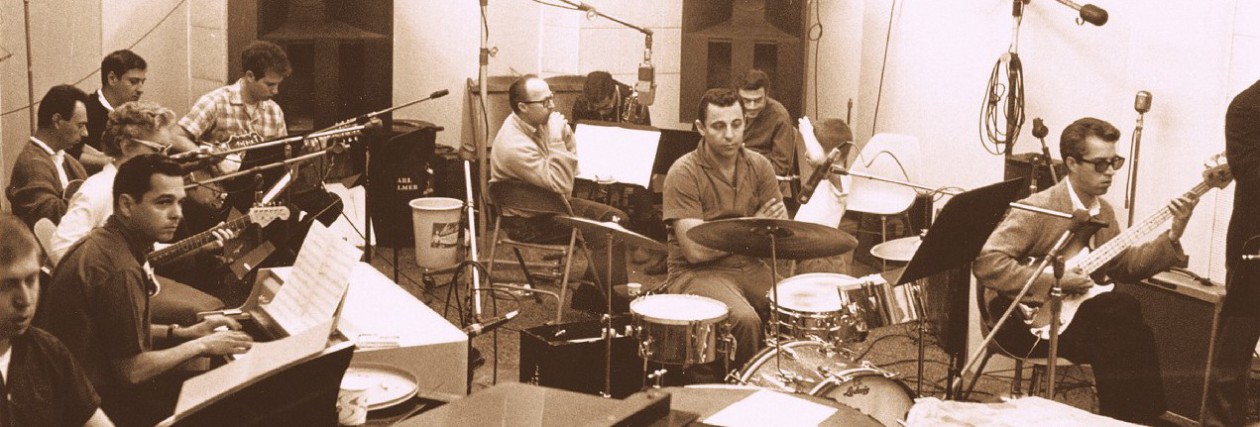Leiber/Stoller,… Pomus/Schuman,… Goffin/King,… Mann/Weill,… Barry/Greenwich,… Bacharach/David,… even a cursory study of label credits on classic 60s US pop singles quickly reveals how the very best of the era’s songwriting came from a bunch of dynamic duos. Some of these songwriting partnerships or husband-and-wife teams almost became household names in themselves along with the acts they wrote for or produced… well, household names at least among music connoisseurs.
But dig deeper than the most well-known Brill Building names and you’ll find more duos worthy of praise and exploration of their work; one could mention Bonner/Gordon,… Wine/Levine,… Sloan/Barri,… Boyce/Hart and none the least Anders/Poncia.
The latter duo, consisting of childhood friends Pete Anders [Peter Andreoli] and Vini Poncia, is one of my all-time favorite songwriter partnerships. These guys could do it all! Sing, write, produce – everything. Despite doing all this at a frantic pace their work was no run of the mill operation.
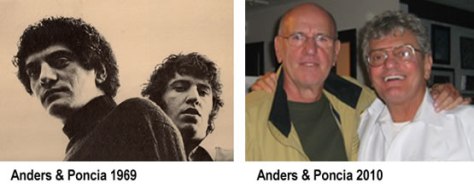
Find a single with an Anders/Poncia label credit and you can be sure that there are something a bit unusual about it. The song might all of a sudden take an interesting turn or throw in an unusual chord – topped with hooks galore and killer vocals. No wonder Phil Spector took notice of these noble knights of quirky chord progressions and considered them worthy of stepping in when Jeff Barry and Ellie Greenwich’s work with Spector had run its course.
When I started this blog the very first person I reached out to for an interview was Pete Anders – besides being a big fan of his work with Vini, I also hadn’t seen him reminisce about his life in music in any interviews and I thought it could be interesting if he’d be willing to do so on Cue Castanets. Peter was up for it but sadly his health problems and passing prevented the interview to take place. When I heard about this I paid my respects to the memory of Peter here:
https://cuecastanets.wordpress.com/2016/03/25/safe-travels-on-the-sunrise-highway-pete/
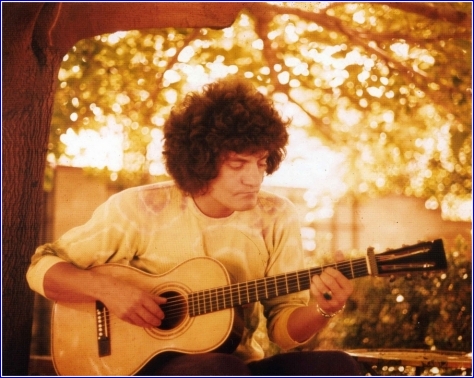
Luckily, Peter’s partner-in-crime Vini Poncia has recently followed up on Peter’s acceptance of an interview and answered the questions I had prepared,… which makes perfect sense seeing that Peter and Vini always did what they did best together, – recording perfect pop in any genre, be it doo wop, rock’n’roll, girl group, wall of sound, Beatles knock offs, surf pop, sunshine pop – you name it!
I would like to thank Peter and Vini’s friend Rick Bellaire for conducting this interview on behalf of Cue Castanets July 2016 in Providence, Rhode Island. Rick is the archive director for the Rhode Island Music Hall of Fame; www.RhodeIslandMusicHallofFame.com
So, please put on your favorite Anders/Poncia tune, sit back and enjoy Vini’s answers to my questions.
————–
Vini, thank you for taking the time to do this interview for Cue Castanets.
You and Peter first met each other in the vocal group The Videls out of Providence, Rhode Island in the late ‘50s. Did the two of you “click” right away as creative partners or was it something that slowly evolved?
We actually first met before The Videls when we were in junior high school. I was on the touch football team from my middle school, Esek Hopkins, and we played against Nathanael Greene Middle School in 1956. Their quarterback was Peter Andreoli. After the game, we talked and hit it off right away. We had all the same interests – sports, girls and mainly music and guitars.
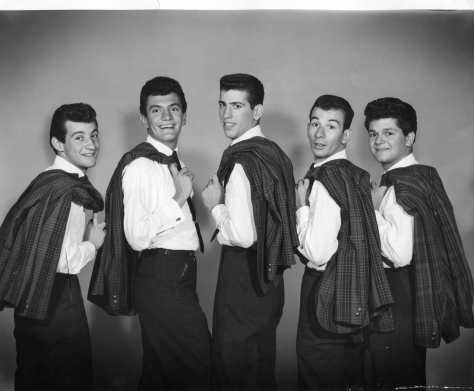
We started to hang around and tried to write songs. We weren’t that prolific. The Videls were started by our friend Bobby Calitri and Peter replaced the lead singer in that group in 1957. They had five singers and a guitarist. I formed a four-piece instrumental band called The Del Rinos with another friend of ours, Frank Spino, who played drums. in 1958, I replaced one of the singers AND the guitarist in The Videls and that became the classic five-piece lineup.
“Mr. Lonely” appears to be the first “Andreoli-Poncia” written song. Is that so?
It was the first released song. We had written a few things and sometimes made demos at our local TV and radio repair shop where the owner had a small recording studio in the backroom. But nothing happened with those songs.
How did the two of you work on songs together from then on? Did one of you, say, mainly write the words and the other the melody / chords? Or did it change from song to song?
We both wrote lyrics and melodies. We’d sit together and try to come up with stuff or we’d bring each other ideas – titles, a bit of melody – as a starter.
In general, we mainly wrote together. We also wrote some folk songs during the early days of The Videls and had a duo on the side we called The Royalty Brothers – like The Everly Brothers.
Even from the early Videls recordings I hear Peter as a very skilled singer with a distinctive vocal style. Who would you say were his biggest influences when you were starting out?
Jimmy Beaumont from The Skyliners, Johnny Maestro of The Crests, Jackie Wilson. Those were his role models and heroes, but Peter was so good that he got to join that club!
Let’s talk about your work while at Philles.
How did your writing relationship with Phil Spector come about? Was his interest piqued by one of your song demos (if so, which one?) or were you teamed up with him?
Paul Case who ran Hill & Range, the publishing company where we worked as songwriters, was Phil’s friend. Phil would test his masters on Paul’s shitty stereo – he figured if they sounded good on a bad record player, they’d sound good anywhere!
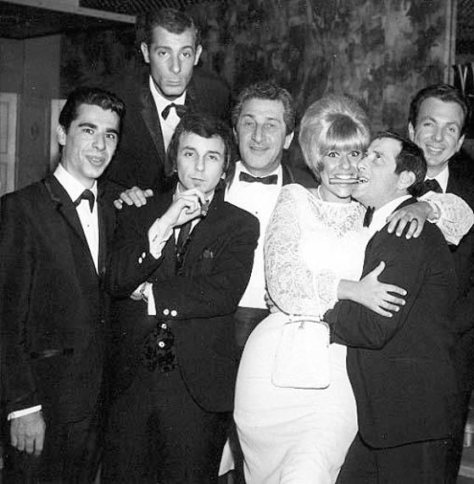
During one visit, Paul knowing that Ellie Greenwich and Jeff Barry were kind of on the way out with Phil, especially because of the arrangement between Phil’s publishing company, Mother Bertha, and Lieber and Stoller’s Company, Trio Music where Jeff and Ellie were signed, said, “Listen to my friends from Providence,” and played Phil some of the stuff we’d done for Snuff Garrett, Bobby Vee, Doc Pomus and one of our records, “Hand Clapping Time.” Phil liked what he heard and told Paul to have us bring him some song ideas.
“The Best Part of Breaking Up” is one of many great songs from that period.
There’s a story going around that you and Peter only had the title/catch phrase for the song (“The best part of breaking up is when you’re making up”) when you pitched the song to Spector and that he immediately sensed a hit from the title alone, asking you to write it. Is this true?
The magic really began in New York when we would bring him Ideas. Yes, we had started it, but we had more than the hook. Phil heard it and he went right to the piano. I had my guitar. Phil helped us finish the first verse. He also wrote the pre-chorus: “Tell me why…” Then he said go home and write the second verse.
We regrouped once all the lyrics were finished and then we started arranging it and getting ready to record it in California.

What was it like to work with him and seeing your songs get the Wall of Sound treatment in the studio?
Well, we played and sang on all the sessions so we were right in the middle of it. For “Best Part,” we were ready, then Phil came up with the bridge and Jack (Nietzsche, Spector’s arranger) worked it right into the song.
In general, we were involved in every aspect of the writing and production, but it really came down to Phil. But he had a LOT of help! He had Hal Blaine, Leon Russell, Steve Douglas…Peter and I were in awe of the process. We had front-row tickets at the “genius” record-making process. On the other hand, we expected nothing less because we came in after Phil had already established his genius at record-making. That blueprint had already been drawn up as far as Larry Levine and engineers and Jack and the charts and the musicians.

Are there any particular songs from that time you’re especially fond of?
The stuff with Darlene has a soft spot in my heart. We were trying to think outside the box: “Strange Love,” “Quiet Guy,” “Stumble and Fall.” They were three very different kinds of songs, not Crystals-esque. We were writing songs for HER which would be different than what she did with the group or on her other sessions for Phil. We wanted to show her growing as an artist.
Darlene Love has actually mentioned numerous times that “He’s a Quiet Guy” is her favorite Philles-era song. I tend to agree. It’s a fantastic piece of work. So it was written directly for her? Did you participate at the session?
Yes, it was written specifically for her and we were on the session.
I’d also like to ask you about “Hold Me Tight.” I absolutely love Peter’s vocal on this recording, credited to The Treasures.
Whose idea was it to rework, and in my opinion vastly improve, a Beatles song so radically? Did Spector record anything else with you on lead that has remained unreleased?
It was Phil’s idea. He said, let’s go make a big, bombastic version of a Beatles tune – cover a Beatles song and give it the “Phil Spector” treatment. Even though there’s no production credit, Phil produced the record and we were the artists instead of simply the composers or arrangers.
We went through the same process he used with every other record. The only difference was it came out on one of his subsidiaries, Shirley Records. And, no, there’s nothing unreleased.
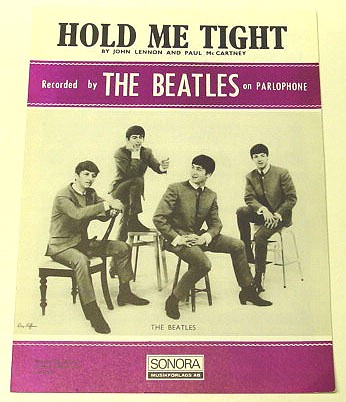
One of your more obscure songs while with Spector is “You’re my Baby’”by Gene Toone & The Blazers, a fun throwback to your street corner doo wop background set to a marching beat. I really love this song.
The feel and beat of it reminds me of an unreleased Philles-era track called “Pretty Girl’”sung by Spector himself. Were you and Peter involved in that song? It has the same type of marching beat and funny lyrics that, among other things, goes: “My name’s Philip and incidentally I ain’t going steady. But you’ve got something that get’s me thinkin’ I may be ready.” There’s a prominent use of harmonica throughout and the chorus goes “You’re so fine. So fine. What’s your number? You’re so fine.” Do you remember this song/production?
I remember it, but we had no involvement.
“Do I Love You” – that bass riff in the intro is pure genius. Do I detect a bit of a Motown influence in that song?
Phil wrote the bass riff. I think I remember him playing that riff early – back in New York – on the left hand of piano when we were writing it. We were certainly aware of what was coming out of Motown and were incorporating certain ideas into what we were doing. They were doing the same thing with Phil’s stuff.
I’ve heard rumors of an unreleased Ronettes track wittten by you and Peter called “Someday (Baby).” Do you remember this one? Did Spector record more songs of yours than what was eventually released?
No recollection. We had an early song with Peer/Southern called “Someday Baby,” but we never brought it to Phil.
There’s of course also The Lovelites. You and Peter did some fantastic stuff with this group – “When I Get Scared” on the Phi-Dan label and the not officially released “Please be my Boyfriend” and “He’s My Eddie Baby.” All great productions!
What would you say you learned as producers from your association with Phil Spector?
The importance of the song and how to “record” arrange meaning thinking of how the RECORD would sound as opposed to just arranging for an orchestra or band. I have one adage from Phil I used to repeat all the time which is simplistic in nature, but he always used to say, “You have to write the best song you can write and you have to make the best record you can make with that song. You cannot have a great song and make an inferior record and can’t make a great record with an inferior song.” You have to be able to discern the difference.
The one other thing he told me that I always used to tell everybody was, “You may not like what you hear on the radio as a hit record or a #1 record – it may not be ‘your kind’ of record – but you better know WHY it was a hit.”
Following up on The Lovelites and “Please Be My Boyfriend” specifically – was that song written by you and Peter? It has never been disclosed who wrote it as an acetate label and sessions sheets don’t feature writing credits.
Also, there’s a version floating around credited to The Crystals. Many believe that the demo isn’t sung by the Crystals but by an unknown group. Do you recognize the voices? This version has puzzled collectors for decades!
I’m not sure, but I think it’s a song we wrote and recorded when we were back working in New York after we were done working with Phil.
We used to record at Broadway Recording Studios at 1697 Broadway in Manhattan. I think it’s a demo and that it’s not Darlene or The Crystals. It could have been any one of the young, black girl groups we used hire to sing our demos. We definitely produced it in the Phil Spector mode – but it was a bad imitation. We may have worked on it with The Lovelites, but not completed it.
You left Spector and Philles Records for Leiber and Stoller’s Red Bird label in 1965. Your first master there was the legendary “New York’s a Lonely Town” under The Tradewinds moniker. A sizeable hit.
How did you come up with this great idea for a song? Did you offer it to Spector before releasing it on Red Bird? Many of the Tradewinds songs have an obvious Beach Boys influence. How did you feel about what Brian Wilson was doing at the time? Did you ever meet him in LA?

Surf music was a huge market then. We heard a ton of it working in L.A. and loved what The Beach Boys were doing. We knew some of them. Brian used to stop in at the Spector sessions to hang out and check out what Phil was doing.
We started the song in L.A. and finished it when we returned to New York. We cut a demo looking to place it with another artist, but when we finished, we knew we had something big and that we should release it ourselves. We went back into the studio and turned the demo into a master. We offered it to Phil first as a courtesy and he knew it was a hit, but he passed on it because he had a bunch of stuff of his own ready to release. So, we brought it to Jerry and Mike and they picked it up.
On Kama Sutra and later Buddah you recorded fantastic stuff under quite a few names: The Tradewinds, The Innocence, The Good Times, etc. But you also released Peter’s first solo single, the majestic “Sunrise Highway” backed with “Baby Baby.” Why a solo single at this time?
Well, the obvious reason is that it features Peter’s incredible vocal. The other reason is that you don’t want to release too many things under the same name one after the other.
We just used the different names as a way to get more records out faster. It was just another “Anders & Poncia” record under a different name. And it also wasn’t the first solo record.

Back in 1962, after The Videls and before The Tradewinds, we released two singles under two different names on two different labels at the same time. Peter’s was “I’m Your Slave” on Corvair and I was “Vince Parelle” on Elmor with “Walk Away.” Nothing ever happened with them which is probably why you didn’t know we’d released “solo” records before.
I’ve heard rumours of an unreleased album borne out of the sessions for the Anders & Poncia single “So It Goes” b/w “Virgin to the Night” on Kama-Sutra. Any truth to this? If so, why was it scrapped?
Yes, it’s true. We worked very closely with Artie Ripp who ran Kama Sutra and Buddah and the three of us decided we should take a crack at writing something for Broadway.
The idea was that instead of it being a standard musical having one long story with songs inserted into the narrative, we would write a song cycle about different aspects of American life and each song would have its own presentation on stage – little vignettes. We wrote, I believe, fifteen songs for the project which was called “Of Love And Life” and story-boarded all the ideas.
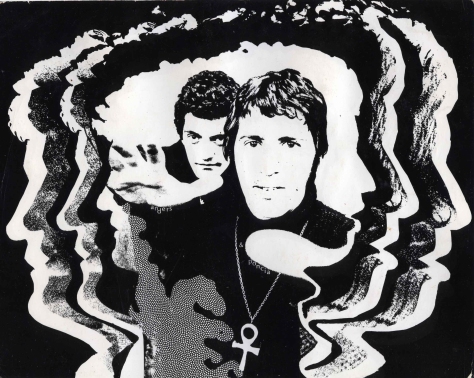
We rented costumes and built sets and did a series of photographs illustrating what each of the story-songs would look like on stage. We recorded demos for all the songs but not finished masters – mostly guitar and voice. The cast album would have been an Anders and Poncia album.
Artie shopped the idea around, but it was an expensive proposition and there were no takers. The idea was put on hold and we recorded two of the best songs, “So It Goes” and “Virgin,” and that became our next single. We left Buddah shortly after that to go to California to work with Richard Perry whom we had worked with at Kama Sutra/Buddah early on.
We worked on the Tiny TIm stuff and we gave another one of the songs from the project to Tim. It’s “Christopher Brady’s Ole Lady” which is on “Tiny Tim’s 2nd Album.” After that, we cut “The Anders & Poncia Album” with Richard for Warner Brothers and included “You Don’t Know What To Do” from the play and that was it. Just the four songs. We didn’t do any more work on the play or on the rest of the songs.

A final question; you and Peter were involved in so many one-off singles that some were bound to fall through the cracks.
A particular favorite of mine is “Thinkin’ ‘bout Me” by The Fairchilds from 1968. What a stunning song and great production – should have been a hit! You and Peter are listed as producers along with your old Videls buddy, Norman Marzano. What do you remember about this song? Was The Fairchilds an actual group or just you guys recording? I think I hear Peter singing background vocals?
The Fairchilds was the group name for The Tradewinds minus me and Pete – a side project. Peter and I go all the way back to The Videls with Norman Marzano and Bobby Calitri. Then they became The Tradewinds with me and Peter.
When we couldn’t go out on tour because we were needed in the studio, we formed a “road” version of the group which included Jim Calvert and Paul Naumann. So, when nothing was happening with our records, we tried to keep the guys busy and they helped us with different projects and we were all signed to Kama Sutra as writers.

We got an offer to produce a record for A&M. So, Norman, Jimmy and Paulie named themselves The Fairchilds and wrote a couple of songs. Peter and I helped them produce the single and, yes, that’s Peter singing with the group. Nothing happened with the record and it was back to business as usual.
Fascinating to learn the story about this great single.
Vini, thank you for taking the time to answer these questions. I’m sure Cue Castanets readers will find your recollections as interesting as I have.
